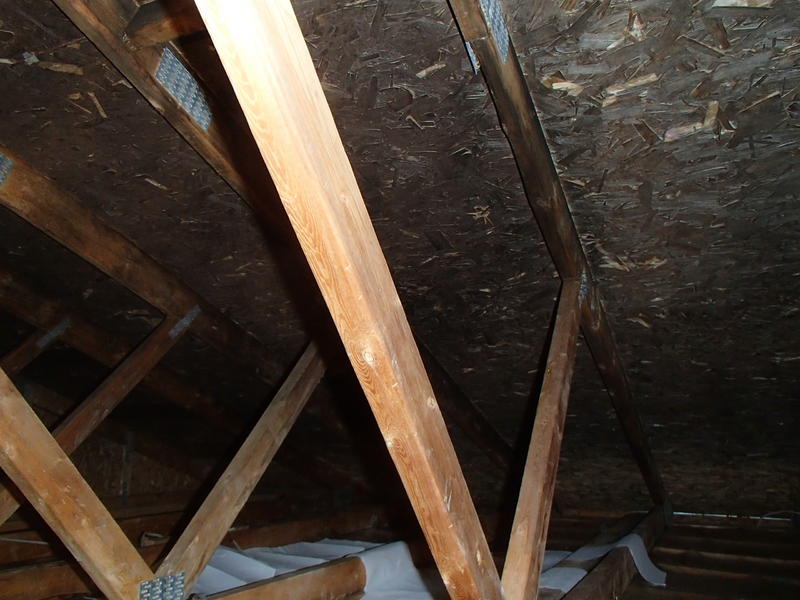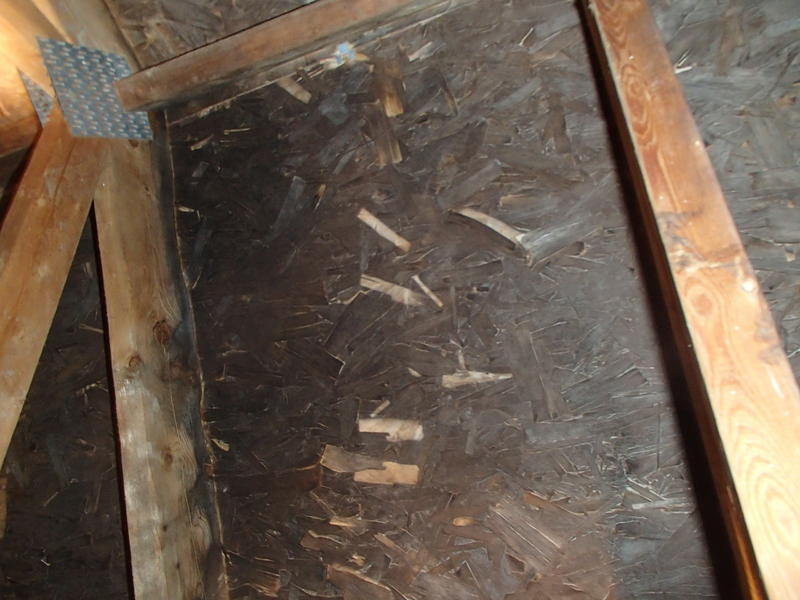It is normal to still have the discolouration visible after a professional remediation?
Yes, but no where near that much
No, they should have soda or ice blast it off. Then it needs an antimicrobial sealer applied over top. If the roof covering is not in great shape, it is more economical to replace the sheathing.
Yes, depending on the product used and what is meant by “professional”. It’s ugly and would better deal with future perception of an imaginary problem if they removed the staining. Paints and sealers are not recommended because they change the rate of equilibration of the material and can cause moisture to become trapped. Check out “MMR”, it removes staining ridiculously fast.
Did you mean RMR-86…looks like expensive bleach to me.
IICRC S520 recommends sealing. They make clear antimicrobial sealers. You want the wood not to soak in moisture, that is why it is called sealing. The wood is dried before any sealer is added. The sealer keeps the mold from growing back. Some mold growth will always remain in the wood grain, thus that is why sealing is important.
Probably a similar product, but not the exact one I was thinking of. They both work the same it looks like. Gets rid of the stains, deals with people’s misperceptions, makes it look pretty. ![]()
I forwarded the info to the client, thanks!
And:
:shock:
Yeah, few advertisements for products relating to mold cleanup can resist the temptation to push the “mold is gold” angle. ![]() What’s sad is how many will spray down an attic with those kinds of products and not go after the moisture problem that caused the mold in the first place. :shock:
What’s sad is how many will spray down an attic with those kinds of products and not go after the moisture problem that caused the mold in the first place. :shock:
Why 654%? That’s a really specific number…
That would be an overstatement. The IICRC S520 you mentioned says on page 21, 5.8.1 and several other locations:
It also reiterates the concern regarding sealants actually causing a build up of moisture on page 22, 5.8.2:
It goes on in section 5.8.2.1 and many sections thereafter to make clear warnings about using sealants which encapsulate growth, create a vapor barrier or are used in place of moisture control or adequate cleaning.
A better way of describing the IICRC S520’s mention of sealants would be to say it recognizes it may be considered in some situations but it does not promote it.
I’m not sure where this information is coming from, but it’s not from the IICRC S520 you mentioned. As quoted above, in the few instances where sealants would be used, they are supposed to be permeable. They are specifically NOT supposed to create a vapor barrier which would prevent moisture exchange. This is stated emphatically along with repeated statements discouraging the improper use of encapsulates throughout the IICRC S520. (e.g.Pages 21, 22, 46, 48, 117, 120, 121, 175, 177) I hope this helps everyone.
Cameron,
You just pointed out that the S520 recommends sealing, so what is your problem?
All approved mold sealers are permeable, also all mold sealers will reduce the absorption of moisture in wood. Would you like me to explain you the basics?
Why are you even quoting sections of the S520 against improper mold removal procedures, which has nothing to do to what I said? Of course, the S520 does not want mold to be removed incorrectly.
No, it promotes the correction of moisture issues and the cleanup of growth as the highest priority. It then acknowledges sealing may happen and provides warnings to prevent it from being done incorrectly. That’s a far cry from you promoting the idea that “the S520 recommends sealing.” I have no problem with correct information. Sealing is not a standard inclusion in the S520s remediation guidelines, it’s an exception.
If all sealers used by remediators were permeable, as you say, then there would be no need for the S520s warnings about sealers. You are correct, a sealer slows the absorption of moisture, which means it will also slow the release of that moisture and can cause damage. This is exactly the issue I and the S520 mentioned above. Please don’t explain the basics to anyone.
Question…wouldn’t remediation include proper removal of the staining?
For most mold remediation contractors, yes. It makes sense to do it since stains will affect people’s perceptions whether there is a problem or not, and people’s perceptions can affect the value of the house. But it’s not an issue of what is proper. Stains are just that, stains. If the moisture issue is addressed, stained wood has the same potential for mold growth as unstained wood.
Cameron,
You is saying not to stop the moisture problem?
When a standard devotes at least a couple pages on how to properly apply antimicrobial coatings, than it is an accepted practice. If there is no staining of wood, than the wood does not need to be sealed, thus that is why it is written as you say “an exception”.
Go back and reread.
Sealers are unnecessary, and sealing the wood is not going to “stop the moisture problem” as you say above. I hope no one is telling their clients that sealers “reduce the absorption of moisture in wood” and “stop the moisture problem”. Both those statements are scientifically and verifiably incorrect.
The sealers main purpose in a mold remediation is not to stop the moisture problem. It is to inhibit mold growth. Anybody who knows any thing about mold knows hyphal fragments remain in the wood grain after aggressive cleaning and will regrow back if the wood is not sealed.
Sealers also restrict the absorption of moisture. Why do you think outside wood is painted or have a sealer applied?
To prevent moisture intrusion from the exterior side of the finish material. The difference is that houses are designed to dry toward the interior where the climate is controlled. Additionally, the back of exterior wood siding is not sealed and it is vented to the exterior. This is not the case when sealers are used on interior framing; they seal the side of the framing through which the drying process would occur.
Seal the framing in a basement or attic, then allow it to sit in typical humid conditions which don’t last a day or two. Or, during a leak, have water saturate the parts of the framing where it could not be sealed. Water will still get in. As the area dries, the release of moisture will take longer in the sealed wood and rot or fungal growth will occur. Unsealed wood will dry out rapidly, sealed won’t.
I’m not sure why you are speaking of sealers as if they are a silver bullet. They are misused by remediators, they have potential to cause worse problems in the long run and they are not a standard recommendation(though they have clear warnings regarding them) by the S520 or any other professional organization.
Keep on living in your imaginary world, Cameron. You will still continue to talk to yourself until you come out of that world.


